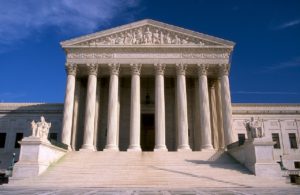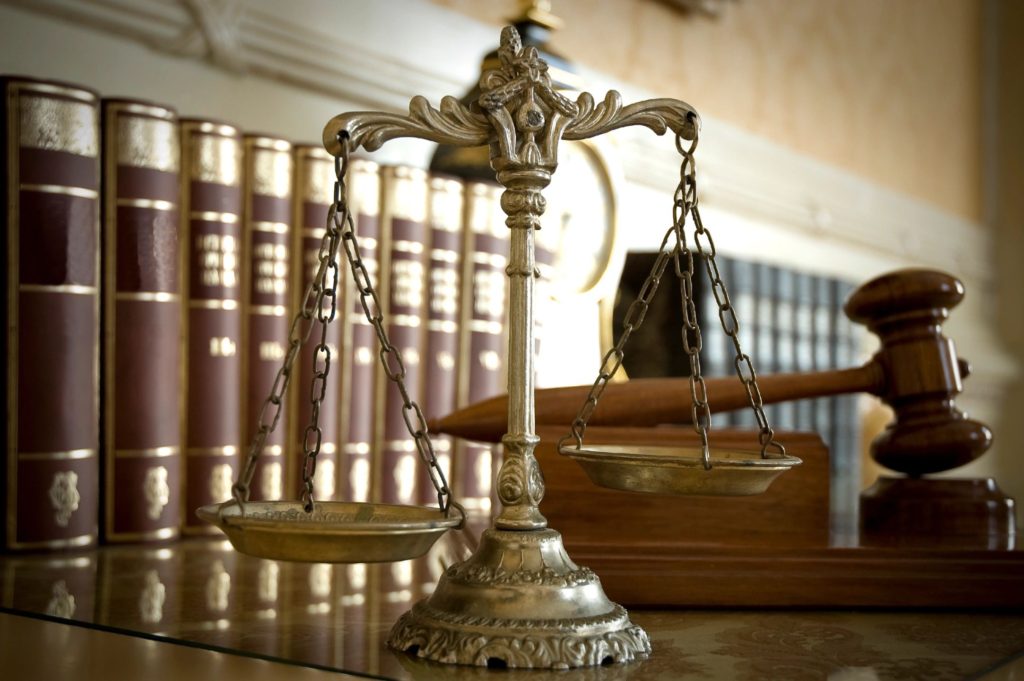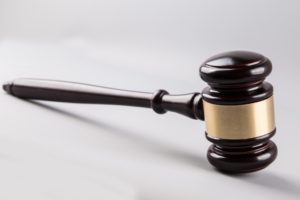By Michael Johnston
When Shawn Ellis extended his middle finger while
riding in the passenger seat of a vehicle on U.S. Highway 52, he likely did not
know that he would become involved in the latest of a string of appellate cases
on the First Amendment.
The First Amendment provides that “Congress shall
make no law . . . abridging the freedom of speech . . . .”[1] Freedom
of speech under the First Amendment was incorporated against the states via the
Fourteenth Amendment, limiting the ability of the states to restrict freedom of
speech under the United States Constitution.[2] Expressive
conduct outside of verbal speech can also merit First Amendment protections if
there is an intent to convey a particularized message and there is a great
likelihood that the message will be understood by those who view it in the
surrounding circumstances.[3]
The extension of one’s middle finger, colloquially
known as shooting or flipping the bird,[4] has
a long history of being used to express emotions ranging from anger and protest
to comfort and familiarity.[5] While
this gesture can be used to express contempt, several courts have been
reluctant to conclude that the middle finger gesture falls into a category of
unprotected speech that can be prosecuted.[6] For
example, the Sixth Circuit recently determined that a police officer did not
have reasonable suspicion or probable cause of criminal activity to stop
plaintiff a second time simply because she extended her middle finger after the
first stop.[7]
The court reasoned that the plaintiff violated no identified law and that “[a]ny
reasonable officer would know that a citizen who raises her middle finger
engages in speech protected by the First Amendment.”[8]
Fighting words, however, are one exception to the
First Amendment; they are words “which by
their very utterance inflict injury or tend to incite an immediate breach of
the peace.”[9]
The Supreme Court further explained that fighting words are not essential to
the discussion of ideas, and any benefit to the social discourse derived from
them is outweighed by society’s interest in morality and order.[10] Despite
the expressive value of extending one’s middle finger, courts are more willing
to conclude that the gesture can support a disorderly conduct charge if there
are other disruptive circumstances or if a third party can testify that they felt
offended or threatened.[11] For
example, the Third Circuit held that a police officer had probable cause to charge
plaintiff with disorderly conduct under the totality of the circumstances,
namely the plaintiff’s display of his middle finger and aggressive driving
directed at another driver on the road.[12]
With additional disruptive circumstances, a court is more likely to conclude
that the speech constitutes fighting words and that the person using such
speech can be charged with disorderly conduct.[13] For expressive
purposes, disorderly conduct statutes have been limited by the Supreme Court to
the proscription of fighting words.[14]
In State v.
Ellis,[15]
the defendant was stopped by a police officer after the officer observed the defendant
extending his middle finger in the officer’s general direction.[16] The
defendant was initially using a waving gesture as his vehicle drove past the
stopped officer, but after the defendant’s vehicle passed the officer, the
defendant changed his gesture to an extended middle finger.[17]
There were other vehicles moving down the highway near the defendant’s vehicle.[18] In
its initial opinion, the North Carolina Court of Appeals concluded that this
conduct was sufficient for an officer to have reasonable suspicion of
disorderly conduct.[19] The
panel then withdrew its initial opinion and substituted it with another
opinion; the panel majority clarified that the officer had reasonable suspicion
of disorderly conduct because there was an objective basis to believe that the
defendant’s gesture could have been directed at a third party and that the
changing gestures suggested that the potential disorderly conduct was
escalating.[20]
While the court noted cases concluding that giving a middle finger to law
enforcement is protected by the First Amendment, the court distinguished them
by concluding that the possibility that defendant’s middle finger could have
been directed at a third party was a sufficient basis for reasonable suspicion
for disorderly conduct.[21] According
to the court, this reasonable suspicion justified the stop and later justified
the defendant’s charge and conviction of resisting, delaying, or obstructing a
public officer for failing to provide his identification.[22]
The standard for a police officer to conduct a
traffic stop is reasonable suspicion of criminal activity,[23]
which is a lower standard than probable cause of criminal activity.[24]
For reasonable suspicion, the police officer must, under the totality of the
circumstances, have specific and articulable facts supporting a suspicion of
criminal activity.[25] An
innocent explanation for suspicious conduct does not defeat reasonable
suspicion,[26]
and innocent conduct can contribute to reasonable suspicion under the totality
of the circumstances.[27]
However, as the dissenting opinion notes, the
majority’s opinion in Ellis seems to
disregard the First Amendment protections for defendant’s speech.[28]
There is a sizeable amount of authority from around the United States
concluding that extending one’s middle finger in the presence of third parties
does not constitute disorderly conduct under the First Amendment.[29] Furthermore,
there is also authority concluding that simply displaying one’s middle finger
is insufficient for reasonable suspicion of criminal activity under the First
Amendment.[30]
In both Cruise-Gulyas v. Minard[31]
and Ellis, for example, an officer
stopped someone after they displayed their middle finger in the direction of
the officer.[32]
While the Sixth Circuit concluded that the officer in Cruise-Gulyas lacked reasonable suspicion to stop the plaintiff in
response to the gesture under the First Amendment, the court of appeals in Ellis distinguished Cruise-Gulyas on the basis that it was unclear whom the gesture was
directed at in Ellis, even though it
seems unlikely that there were no other drivers on the street who might have
seen the gesture in Cruise-Gulyas.[33]
Just as there was no reasonable suspicion of criminal activity and “[a]ny
reasonable officer would know that a citizen who raises her middle finger
engages in speech protected by the First Amendment” in Cruise-Gulyas,[34]
the same should be true in Ellis. Furthermore,
other courts have viewed the middle finger as sufficient for reasonable
suspicion or probable cause of criminal activity only when there are other
disruptive circumstances associated with the conduct or a third party can
testify that they felt offended or threatened.[35]
Unlike in Favata v. Seidel,[36] there
were no other disruptive circumstances in Ellis,
such as reckless driving, to justify reasonable suspicion or probable cause of disorderly
conduct.[37]
The Ellis opinion does find some
support in North Carolina case law, but one of the more helpful cases for the Ellis opinion is also likely
inconsistent with other authorities interpreting the First Amendment.[38]
On a practical note, the Ellis opinion will give law enforcement broader discretion to stop
people, even if the stops are only motivated by personal animus. While the
motivation of an officer might not be legally relevant when determining whether
the officer had reasonable suspicion,[39]
such stops can undermine community faith in law enforcement.[40] To
justify such a stop, an officer would only need to claim that the offensive
conduct of the defendant occurred in the presence of a third party. As in Ellis, the State would not need to provide
evidence that the third party was actually offended by the gesture or even
observed the gesture.[41] If
the analysis of this question focused purely on reasonable suspicion standards
under North Carolina law, this outcome might be logical due to the lower
standard required for reasonable suspicion. However, in light of the
protections for expressive conduct under the First Amendment, law enforcement officers
stopping someone simply for using expressive, albeit distasteful, conduct in
the presence of others is inconsistent with our constitutional freedoms and
history.[42]
Given our nation’s long history of protecting dissident speech under the First
Amendment even when it happens to be offensive, extending a middle finger
should not be a criminal offense, and it should not be treated as reasonable
suspicion of a criminal offense simply because a third party might have seen
it.
Mr. Ellis is in the process of appealing the panel’s
decision.[43]
In light of this appeal, the North Carolina Supreme Court should establish that
the First Amendment protects expressive conduct in the form of extending a
middle finger in public.
[1] U.S. Const. amend. I.
[2] U.S. Const. amend XIV, § 1; see
Stromberg v. California, 283 U.S. 359, 368–70 (1931); Gitlow v. New York, 268
U.S. 652, 666 (1925).
[3] See Texas v. Johnson, 491 U.S. 397, 404 (1989) (quoting Spence v.
Washington, 418 U.S. 405, 411–12 (1974)).
[4] See Ira P. Robbins, Digitus Impudicus:
The Middle Finger and the Law, 41 U.C.
Davis L. Rev. 1403, 1405–06 (2008).
[5] See id. at 1407–10.
[6] See Cruise-Gulyas v. Minard, 918 F.3d 494, 497 (6th Cir. 2019)
(holding that plaintiff’s extension of middle finger did not justify officer
stopping her a second time because the gesture was protected under the First
Amendment and the gesture itself did not create probable cause or any
reasonable suspicion of any criminal act); Swartz v. Insogna, 704 F.3d 105, 110
(2d Cir. 2013) (holding that traffic stop was not lawful because plaintiff
giving officer middle finger while riding in vehicle did not create a reasonable
suspicion of criminal activity); Sandul v. Larion, 119 F.3d 1250, 1255 (6th
Cir. 1997) (holding that, despite defendant directing his middle finger and
profane language at protestors while driving, “a reasonable officer should have
known that the words and gestures employed by Sandul amounted to protected
speech” because they were not likely to incite an immediate breach of the peace
when Sandul’s vehicle was traveling quickly on the opposite side of the street
from the protestors, the incident only lasted a few seconds, there was no
evidence that any protestor was offended or even acknowledged the conduct
except for the officer, and there was no face-to-face contact between Sandul
and protestors), cert. dismissed, 522
U.S. 979 (1997); Duran v. City of Douglas, 904 F.2d 1372, 1378 (9th Cir. 1990)
(holding that vehicle passenger’s use of profanity and display of middle finger
to police officer protected by the First Amendment); Youngblood v. Qualls, 308
F. Supp. 3d 1184, 1190, 1195–97 (D. Kan. 2018) (holding that plaintiff’s
display of middle finger and use of profanity directed at neighbor’s house was
insufficient for probable cause for disorderly conduct under Kan. Stat. Ann. § 21-6203 and the First
Amendment); Brown v. Wilson, No. 1:12-CV-1122-DAE, 2015 U.S. Dist. LEXIS 88871,
at *8–14 (W.D. Tex. July 9, 2015) (holding that plaintiff’s middle finger to
police officer while driving was not in violation of Texas’s disorderly conduct
statute and did not fall under the fighting words exception to the First
Amendment because there was no indication of actual or threatened violence
tending to incite an immediate breach of the peace); Corey v. Nassan, No.
05-114, 2006 U.S. Dist. LEXIS 68521, at *23–37 (W.D. Pa. Sept. 25, 2006)
(holding that plaintiff’s alleged raising of his middle finger to police
officer while driving was protected by the First Amendment in part because of
the absence of “some particularized showing that the gesture in the specific
factual context constitutes ‘fighting words’ or is otherwise illegal”); Perkins
v. City of Gahanna, No. C2-99-533, 2000 U.S. Dist. LEXIS 23209, at *5–11 (S.D.
Ohio Sept. 21, 2000) (holding that plaintiff’s display of middle finger to
police officer as he was leaving a police station was protected by the First
Amendment and not disorderly conduct); Nichols v. Chacon, 110 F. Supp. 2d 1099,
1101, 1110 (W.D. Ark. 2000) (holding that officer improperly charged plaintiff
with disorderly conduct after officer observed plaintiff display his middle
finger while driving because the disorderly conduct statute, Ark. Code Ann. § 5-71-207(a)(3), was
limited to fighting words and the display of one’s middle finger did not
constitute fighting words); United States v. McDermott, 971 F. Supp. 939,
942–43 (E.D. Pa. 1997) (holding that defendant’s use of profanity with only
officers and two other people present insufficient for fighting words exception
under disorderly conduct statute); Cook v. Bd. of the Cty. Comm’rs, 966 F.
Supp. 1049, 1052 (D. Kan. 1997) (holding that “the Court cannot infer that a
reasonable police officer would necessarily believe that plaintiff was engaged
in disorderly conduct or that — in light of clearly established law and the
information known to Officer Drake — a reasonable police officer would have
had probable cause to arrest plaintiff and charge him with disorderly conduct
in violation of Kansas Law” when plaintiff displayed his middle finger while
driving past officer’s parked patrol car); Freeman v. State, 805 S.E.2d 845,
849–51 (Ga. 2017) (holding that defendant’s disorderly conduct conviction based
on his display of his middle finger in church was improper because the statute Ga. Code Ann. § 16-11-39(a)(1), as
applied to expressive conduct under the First Amendment, only criminalized
fighting words and there was no evidence that defendant engaged in any other
threatening conduct or intended anything other than protest against secular
education); In re Fechuch, No. 2005 AP 02 0012, 2005 Ohio App. LEXIS 3941, at
*3–9 (Ohio Ct. App. Aug. 16, 2005) (holding that there was insufficient
evidence to support defendant’s conviction for disorderly conduct because
defendant’s use of profanity and her middle finger did not constitute fighting
words under the First Amendment as they were not inherently likely to provoke a
violent reaction from the ordinary citizen); Coggin v. State, 123 S.W.3d 82,
87–88, 91–92 (Tex. App. 2003) (holding that the evidence at trial was legally
insufficient to uphold defendant’s conviction of disorderly conduct after
defendant in car displayed his middle finger to driver of another car because
the interaction was brief, there was no actual or threatened violence, and the
interaction was not face-to-face).
[7] See Cruise-Gulyas, 918
F.3d at 497.
[8] See id.
[9] See Chaplinsky v. New Hampshire, 315 U.S. 568, 571–72 (1942)
(footnote omitted).
[10] See id.
[11] See Favata v. Seidel, 511 F. App’x. 155, 159–60 (3d Cir. 2013)
(holding that there was probable cause for disorderly conduct because plaintiff
was driving recklessly in addition to displaying his middle finger); City of
Akron v. Lorenzo, No. 20475, 2001 Ohio App. LEXIS 4327, at *8 (Ohio Ct. App.
Sept. 26, 2001) (holding that it was not a manifest miscarriage of justice for
a trial court to find defendant guilty of disorderly conduct under fighting
words exception because defendant repeatedly shouted profanities at officers
and displayed his middle finger); State v. Wood, 679 N.E.2d 735, 739–40 (Ohio.
Ct. App. 1996) (holding that defendant’s conviction for disorderly conduct was proper
after concluding that defendant’s actions, namely approaching university police
officers and then repeatedly using profanities against them and displaying his
middle finger to them, constituted fighting words); In re S.J.N-K., 647 N.W.2d
707, 711–13 (S.D. 2002) (holding that there was sufficient evidence to justify
a guilty jury verdict for disorderly conduct under the fighting words exception
after defendant repeatedly displayed middle finger and mouthed profanity to
school principal while following principal in car); Estes v. State, 660 S.W.2d
873, 874–75 (Tex. App. 1983) (holding that there was sufficient evidence to
justify a guilty jury verdict for disorderly conduct after defendant displayed
his middle finger to high school principal and principal resisted “animal
instinct to retaliate” because the gesture could have constituted fighting
words to an average person).
[12] See Favata, 511 F. App’x
at 156–57, 159–60.
[13] See, e.g., Wood, 679
N.E.2d at 739–40 (holding that defendant’s conviction for disorderly conduct
proper after concluding that defendant’s actions, namely approaching university
police officers and then repeatedly using profanities against them and
displaying his middle finger to them, constituted fighting words).
[14] See Gooding v. Wilson, 405 U.S. 518, 527–28 (1972); State v.
Summrell, 192 S.E.2d 569, 574–76 (N.C. 1972), overruled in part on other grounds in State v. Barnes, 380 S.E.2d
118, 119 (N.C. 1989).
[15] No. COA18-817, 2019 N.C. App. LEXIS
713 (N.C. Ct. App. Aug. 20, 2019)
petition for writ of supersedeas filed, motion
for temporary stay allowed, No. 340A19-1, 2019 N.C. LEXIS 848 (N.C. Aug.
29, 2019). While this case was officially filed for publication by the North
Carolina Court of Appeals on August 20, 2019, it has not been given an official
reporter designation at the time of this publication.
[16] Id. at *7–8.
[17] Id.
[18] Id. at *6.
[19] N.C.
Gen. Stat. § 14-288.4(a)(2) (2017); State v. Ellis, No. COA18-817, 2019
N.C. App. LEXIS 628, at *6–8 (N.C. Ct. App. Aug. 6, 2019), withdrawn (Aug. 13, 2019), modified,
No. COA18-817, 2019 N.C. App. LEXIS 713 (N.C. Ct. App. Aug. 20, 2019), petition for writ of supersedeas filed, motion for temporary stay allowed, No. 340A19-1,
2019 N.C. LEXIS 848 (N.C. Aug. 29, 2019).
[20] Ellis, 2019 N.C. App. LEXIS 713, at *9–11.
[21] Id.
[22] See id. at *9–12.
[23] See State v. Barnard, 658 S.E.2d 643, 645 (N.C. 2008).
[24] See State v. Johnson, 803 S.E.2d 137, 139 (N.C. 2017).
[25] See Terry v. Ohio, 392 U.S.
1, 20–22 (1968); State v. Styles, 665 S.E.2d 438, 443–40 (N.C. 2008).
[26] See United States v. Arvizu, 534 U.S. 266, 277 (2002); State v.
Williams, 726 S.E.2d 161, 167 (N.C. Ct. App. 2012).
[27] See United States v. Sokolow, 490 U.S. 1, 9–11 (1989); Terry, 392 U.S. at 22.
[28] See State v. Ellis, No. COA18-817, 2019 N.C. App. LEXIS 713, at *22
(N.C. Ct. App. Aug. 20, 2019) (Arrowood, J., dissenting), petition for writ of supersedeas filed, motion for temporary stay allowed, No. 340A19-1, 2019 N.C. LEXIS
848 (N.C. Aug. 29, 2019).
[29] See Sandul v. Larion, 119 F.3d 1250, 1255 (6th Cir. 1997) (holding
that, despite defendant directing his middle finger and profane language at
protestors while driving, “a reasonable officer should have known that the
words and gestures employed by Sandul amounted to protected speech” because
they were not likely to incite an immediate breach of the peace when Sandul’s
vehicle was traveling quickly on the opposite side of the street from the
protestors, the incident only lasted a few seconds, there was no evidence that
any protestor was offended or even acknowledged the conduct except for the
officer, and there was no face-to-face contact between Sandul and protestors), cert. dismissed, 522 U.S. 979 (1997); Youngblood v. Qualls, 308 F.
Supp. 3d 1184, 1190, 1195–97 (D. Kan. 2018) (holding that plaintiff’s display
of middle finger and use of profanity directed at neighbor’s house was
insufficient for probable cause for disorderly conduct under Kan. Stat. Ann. § 21-6203 and the First
Amendment); United States v. McDermott, 971 F. Supp. 939, 942–43 (E.D. Pa.
1997) (holding that defendant’s use of profanity with only officers and two
other people present insufficient for fighting words exception under disorderly
conduct statute); Freeman v. State, 805 S.E.2d 845, 849–51 (Ga. 2017) (holding
that defendant’s disorderly conduct conviction based on his display of his
middle finger in church was improper because the statute Ga. Code Ann. § 16-11-39(a)(1), as
applied to expressive conduct, only criminalizes fighting words and there was
no evidence that defendant engaged in any other threatening conduct or intended
anything other than protest against secular education); Coggin v. State, 123
S.W.3d 82, 91–92 (Tex. App. 2003) (holding that the evidence at trial was
legally insufficient to uphold defendant’s conviction of disorderly conduct
after defendant in car displayed his middle finger to driver of another car
because the interaction was brief, there was no actual or threatened violence,
and the interaction was not face-to-face).
[30] See, e.g., Cruise-Gulyas v. Minard, 918 F.3d 494, 497 (6th Cir.
2019) (holding that plaintiff’s extension of middle finger did not justify
officer stopping her a second time because the gesture was protected under the
First Amendment and the gesture itself did not create probable cause or any
reasonable suspicion of any criminal act); Sandul,
119 F.3d at 1255.
[31] 918 F.3d 494 (6th Cir. 2019).
[32] See id. at 497; Ellis, 2019 N.C. App. LEXIS 713, at *
7–8.
[33] See Cruise-Gulyas, 918
F.3d at 495–97; Ellis, 2019 N.C. App.
LEXIS 713, at *6–10.
[34] See Cruise-Gulyas, 918
F.3d at 497.
[35] See, e.g., Favata v. Seidel, 511 F. App’x. 155, 159–60 (3d Cir.
2013) (holding that there was probable cause for disorderly conduct because
plaintiff was driving recklessly in addition to displaying his middle finger);
State v. Wood, 679 N.E.2d 735, 739–40 (Ohio. Ct. App. 1996) (holding that
defendant’s conviction for disorderly conduct was proper after concluding that
defendant’s actions, namely approaching university police officers and then
repeatedly using profanities against them and displaying his middle finger to
them, constituted fighting words).
[36] 511 F. App’x. 155 (3d Cir. 2013).
[37] See id. at 156–57, 159–60;
Ellis, 2019 N.C. App. LEXIS 713, at
*6–10.
[38] See In re V.C.R., 742 S.E.2d 566, 568, 570–71 (N.C. Ct. App. 2013)
(holding that officer had reasonable suspicion to seize teenage defendant for
disorderly conduct under N.C. Gen. Stat. §
14-288.4(a)(2) after officer began driving away and defendant said, “What the
fuck, man?”). It is unlikely that a reasonable person would sincerely believe that
a teenager’s use of what was likely rhetorical profanity amongst friends would be
plainly likely to provoke violent retaliation and thereby cause a breach of the
peace. Furthermore, such speech is likely protected by the First Amendment. Compare id., with Cruise-Gulyas, 918 F.3d at 497 (holding
that officer’s second stop of plaintiff after plaintiff extended her middle
finger was not based on reasonable suspicion of any criminal act and that
plaintiff’s gesture was protected under the First Amendment).
[39] See Whren v. United States, 517 U.S. 806, 813 (1996); State v. Nicholson,
813 S.E.2d 840, 846 (N.C. 2018).
[40] See Albert J. Reiss, Jr., The Police
and the Public 175–76 (1971).
[41] See State v. Ellis, No. COA18-817, 2019 N.C. App. LEXIS 713, at *2–3
(N.C. Ct. App. Aug. 20, 2019); id. at
*22 (Arrowood, J., dissenting).
[42] See, e.g., Texas v. Johnson, 491 U.S. 397, 414 (1989); Cohen v.
California, 403 U.S. 15, 25–26 (1971).
[43] See State v. Ellis, No. COA18-817, 2019 N.C. App. LEXIS 713 (N.C.
Ct. App. Aug. 20, 2019), petition for
writ of supersedeas filed, motion for
temporary stay allowed, No. 340A19-1, 2019 N.C. LEXIS 848 (N.C. Aug. 29,
2019).






